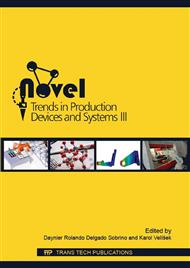[1]
I. Selimovic, Improved algorithms for the projection of points on NURBS curves and surfaces, Computer Aided Geometric Design. 23(2006) 439–445.
DOI: 10.1016/j.cagd.2006.01.007
Google Scholar
[2]
E. van den Berg, W.F. Bronsvoort, J. S. M. Vergeest, Freeform feature modeling: concepts and prospects, Computers in Industry. 49 (2002) 217-233.
DOI: 10.1016/s0166-3615(02)00080-5
Google Scholar
[3]
C. K. Toh, Design, evaluation and optimization of cutter path strategies when high speed machining hardened mold and die materials, Materials and Design. 26 (2005) 517–533.
DOI: 10.1016/j.matdes.2004.07.019
Google Scholar
[4]
I. Česáková, M. Zetek, V. Švarc, Evaluation of cutting tool parameters, in: 24th DAAAM International Symposium, DAAAM International, Vienna, 2014, pp.1-6.
DOI: 10.1016/j.proeng.2014.03.098
Google Scholar
[5]
A. M. Ramos, C. Relvas, J. A. Simões, The influence of finishing milling strategies on texture, roughness and dimensional deviations on the machining of complex surfaces, J. Materials Processing Technology. 136 (2003) 209–216.
DOI: 10.1016/s0924-0136(03)00160-2
Google Scholar
[6]
M. Kaymakci, I. Lazoglu, Tool path selection strategies for complex sculptured surface machining, Machining Science and Technology. 12 (2008) 119–132.
DOI: 10.1080/10910340801913979
Google Scholar
[7]
J. Peterka, P. Pokorný, M. Polakovič, I. Buranský, Surface roughness by copy milling, Manufacturing and Industrial Engineering. 8 (2009) 15 -16.
Google Scholar
[8]
J. Beňo, I. Maňková, Technologické a materiálové činitele obrábania, Vienala, Košice, (2004).
Google Scholar
[9]
Y. Quinsat, L. Sabourin, C. Lartigue, Surface topography in ball end milling process: Description of a 3D surface roughness parameter, J. Materials Processing Technology. 195 (2008) 135–143.
DOI: 10.1016/j.jmatprotec.2007.04.129
Google Scholar
[10]
N. Vidakis, A. Antoniadis, C. Savakis, P. Gotsis, Simulation of ball end tools milling, in: International Conference ICPR, Prague, 2001, p.1 – 9.
Google Scholar
[11]
J. Beňo, Teoretické základy inovačných technológií, SjF TU v Košiciach, Košice, (2010).
Google Scholar
[12]
K. Schützer, E. Abele, C. Stroh, C. von Gyldenfeldt, Using advanced CAM-systems for optimized hsc-machining of complex freeform surfaces, J. the Brazilian Society of Mechanical Sciences and Engineering. 29 (2007) 313-316.
DOI: 10.1590/s1678-58782007000300012
Google Scholar
[13]
A. Logins, T. Torims, The influence of high-speed milling strategies on 3D surface roughness parameters, Procedia Engineering. 100 (2015) 1253-1261.
DOI: 10.1016/j.proeng.2015.01.491
Google Scholar
[14]
P. Ižol, M. Fabian, M. Kopas, G. Fedorko, Evaluation of Machining Strategies for Production of Free Form Surfaces Using 3-Axle Milling, Manufacturing Technology. 13 (2013) 458-465.
DOI: 10.21062/ujep/x.2013/a/1213-2489/mt/13/4/458
Google Scholar
[15]
K. Erkorkmaz, S.E. Layegh, I. Lazoglu, H. Erdim, Feed rate optimization for freeform milling considering constraints from the feed drive system and process mechanics, CIRP Annals - Manufacturing Technology. 62 (2013) 395–398.
DOI: 10.1016/j.cirp.2013.03.084
Google Scholar
[16]
P. Krajnik, J. Kopač, Modern machining of die and mold tools, J. Materials Processing Technology. 157–158 (2004) 543–552.
DOI: 10.1016/j.jmatprotec.2004.07.146
Google Scholar


